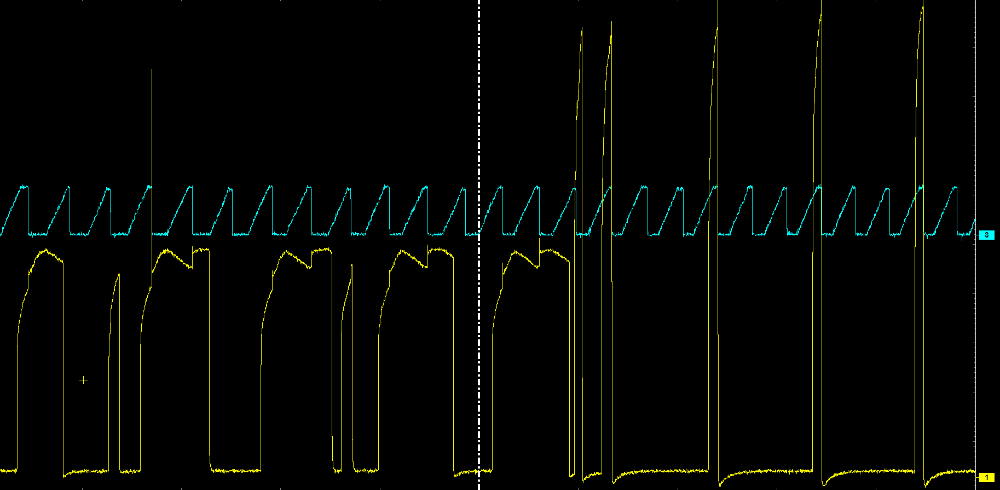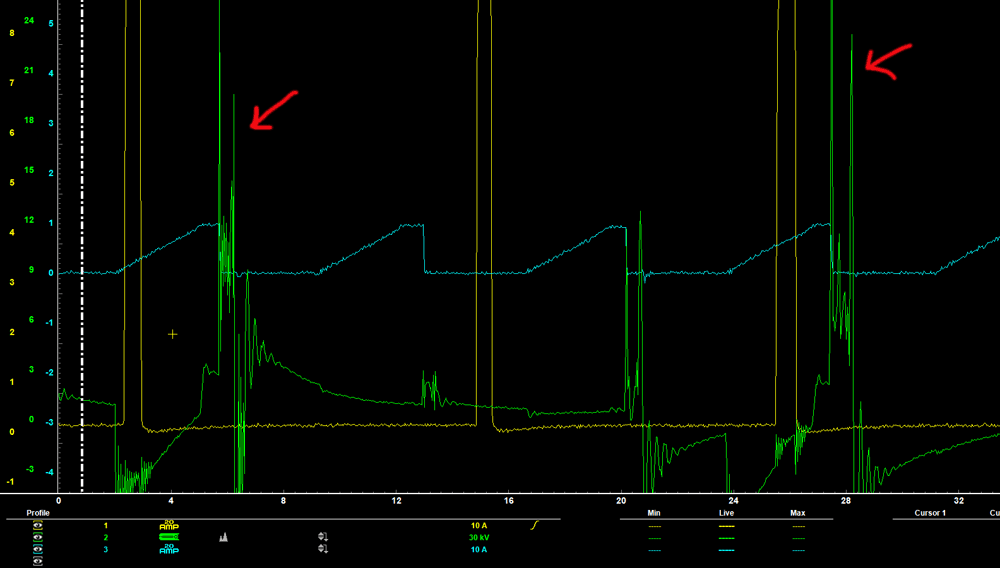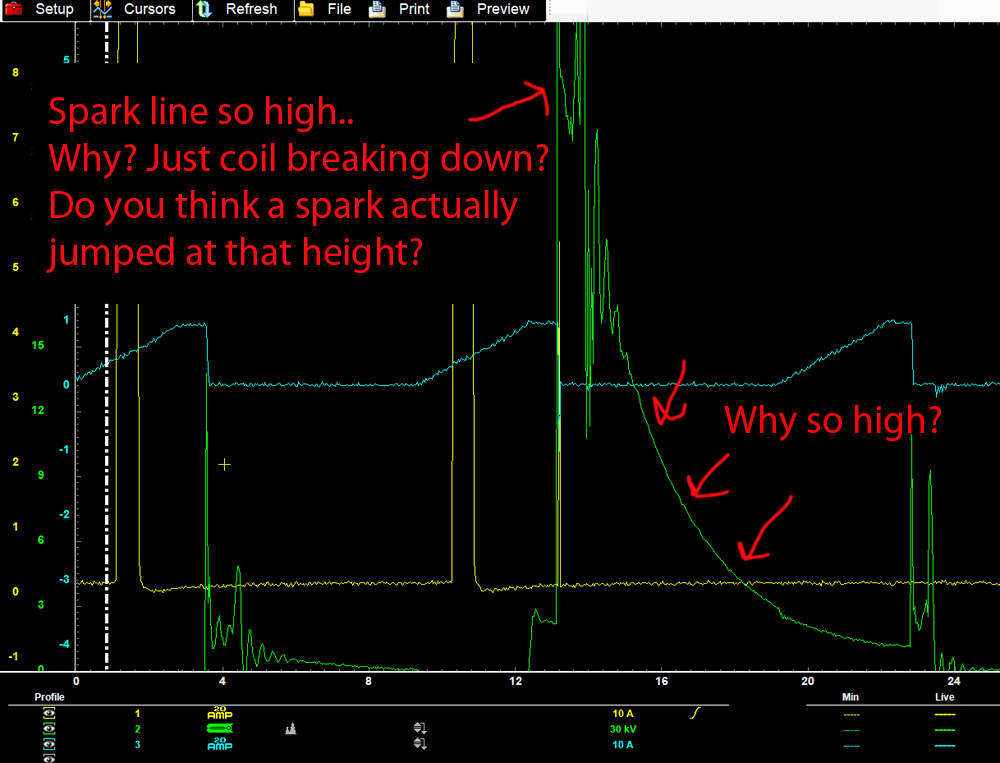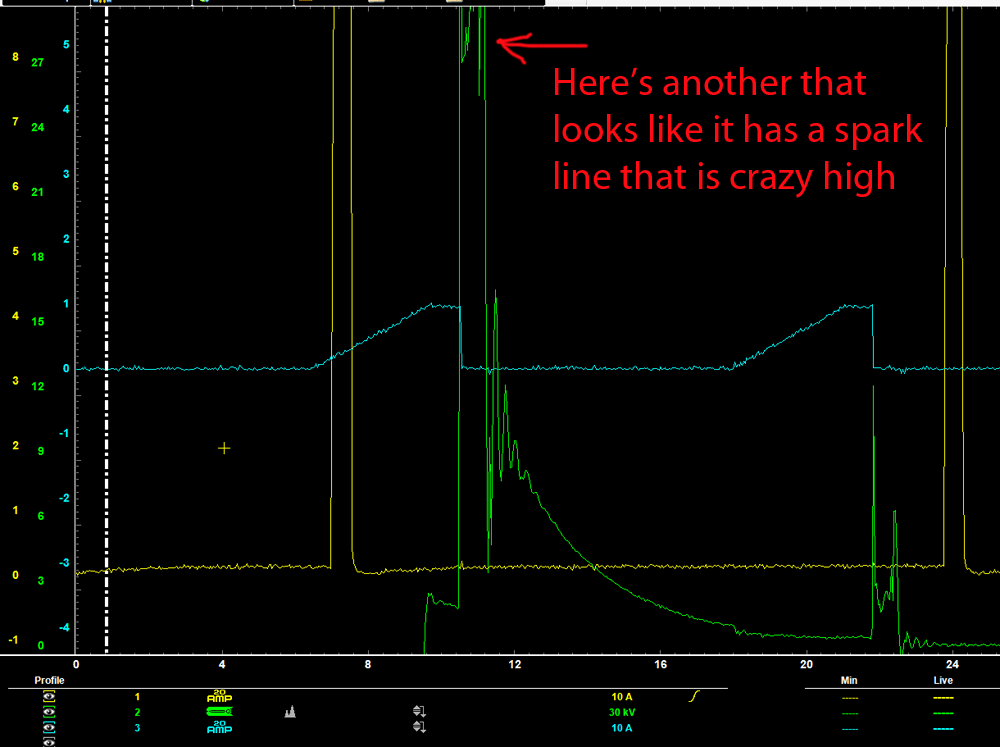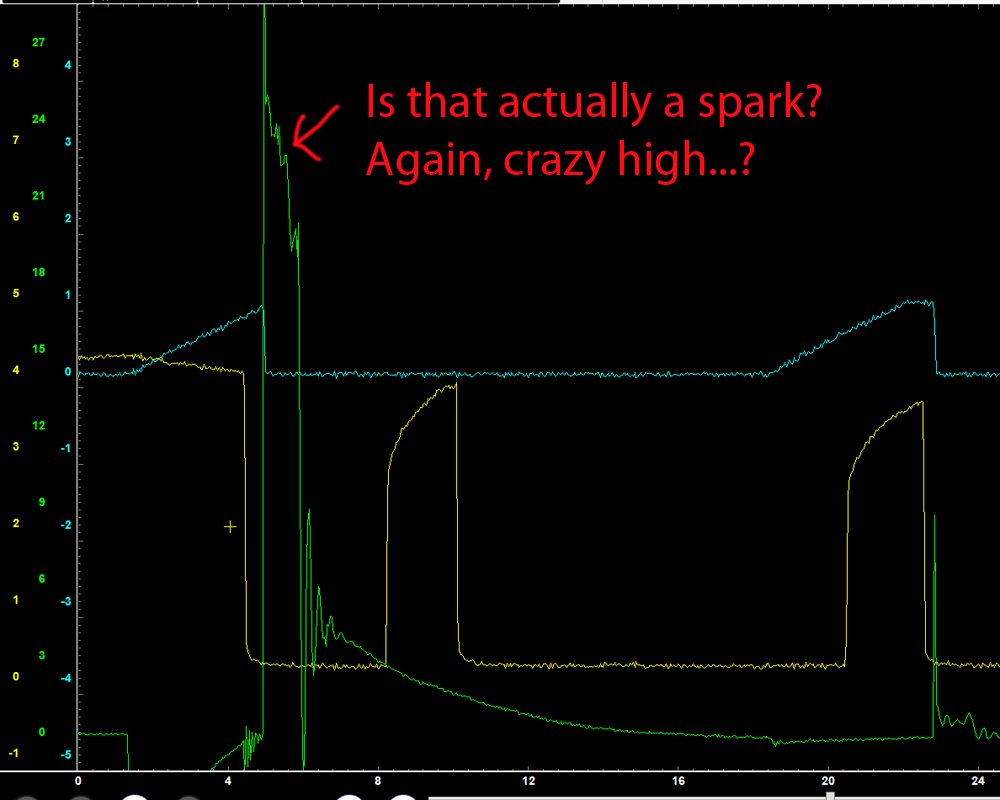*** Restricting New Posts to SD Premium Members ONLY *** (09 May 2025)
Just made a new account? Can't post? Click above.
Secondary Ignition Waveform Questions
- ecwurban
-
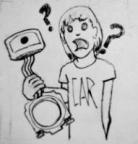 Topic Author
Topic Author
- Offline
- Premium Member
-

- Posts: 125
- Thank you received: 25
This capture is on a 89 Pontiac 6000 with the 2.8L V6. It's a waste spark ignition coil system. The problem with this vehicle was shorted fuel injectors. They would short out when warm and vehicle would result in a no start until they cooled off. They started really messing with the fuel injector driver. Sometimes the driver wouldn't turn off and other times it'd cycle the fuel injector more often than it should. I'm not sure if this driver tom-foolery had an effect on the weird secondary pattern or if it was just a matter of the coil being over-streesed from the lean misfires.
Here's a capture of the fuel injectors freaking out. Yellow trace is an amp clamp on the power feed to the injectors and blue is an amp clamp on the power feed to the coils.
This next capture has the same two channels plus a secondary channel. It's showing the tell-tale lean misfire signature. I'm still all good with this.
BUT... some of the secondary captures on this car I can't explain. Especially since after the injectors were replaced the car ran smooth without any misfires...
So ya. What are your thoughts? I hate looking at secondary ignition and knowing that there is so much more information being displayed that I'm missing out on...
Please Log in or Create an account to join the conversation.
- SailorBob
-

- Offline
- Elite Member
-

Put your scale to 1 ms / div and look at both the amp and voltage of the ignition waveform.
Please Log in or Create an account to join the conversation.
- ecwurban
-
 Topic Author
Topic Author
- Offline
- Premium Member
-

- Posts: 125
- Thank you received: 25
SailorBob wrote: Danner has a good video on common secondary waveform faults:
I've gone through his secondary videos before. They're great for getting you started and finding misfires, etc. I'm more interested in the grey area stuff. A lot of times you grab a secondary trace and get a pattern that doesn't look "good" but it's not a misfire. I want to learn what kind of information I can discern from that. Stuff that you don't see in normal videos/books. As in why those traces I posted appear to have 20+kV spark lines...
SailorBob wrote: Put your scale to 1 ms / div and look at both the amp and voltage of the ignition waveform.
Those screenshots are zoomed out. Even when I zoomed in I didn't see any extra detail that was overly pertinent. Was mainly interested in repetition. And the blue traces are the ignition current ramps.
Please Log in or Create an account to join the conversation.
- Chad
-

- Offline
- Moderator
-

- I am not a parts changer.
- Posts: 2126
- Thank you received: 711
"Knowledge is a weapon. Arm yourself, well, before going to do battle."
"Understanding a question is half an answer."
I have learned more by being wrong, than I have by being right.
Please Log in or Create an account to join the conversation.
- ecwurban
-
 Topic Author
Topic Author
- Offline
- Premium Member
-

- Posts: 125
- Thank you received: 25
pole71 wrote: Check your plugs and wires. Are the wires firmly connected, on both ends? How big is the gap on the spark plugs?
That's why I want to learn as much as I possibly can about interpreting secondary waveforms. Some vehicles can take 2 hours to inspect the wires and the plugs... Time is that all important thing nowadays. Getting as much information in as short amount of time as possible.
Please Log in or Create an account to join the conversation.
- Chad
-

- Offline
- Moderator
-

- I am not a parts changer.
- Posts: 2126
- Thank you received: 711
It won't tell you the "why".
"Knowledge is a weapon. Arm yourself, well, before going to do battle."
"Understanding a question is half an answer."
I have learned more by being wrong, than I have by being right.
Please Log in or Create an account to join the conversation.
- ecwurban
-
 Topic Author
Topic Author
- Offline
- Premium Member
-

- Posts: 125
- Thank you received: 25
pole71 wrote: It won't tell you the "why".
That's the whole point of secondary ignition though. Is to tell you why it's misfiring. It's misfiring because it's lean. It's misfiring because there's low compression. It's misfiring because it's shorted. Etc. Same thing with in-cylinder pressure waveforms. The waveform is just a direct representation of what's physically happening. Every part of the pattern is telling you something if you know how to interpret it. I want to be able to get as much as possible from the captures. Diagnostic time is paid time therefore your time is limited. Customer's don't want to spend money on that. If I'm pulling plugs and wires to inspect them and someone comes along that can get all that information with a labscope in 5-10 minutes then I'll lose out on the diagnostic jobs.
Prime example is this vehicle. The problem was with the injectors. It did not have any ignition misfires. When the injectors were good the secondary pattern was good. Pulling plugs and wires wouldn't have told me anything. But if I can learn more about what was happening in the pattern then I'll have more tools to diagnose more difficult jobs. Especially very intermittent problems. You may only get one small capture where the problem was occurring. If I want to be able to go to a big enough shop where I can do this sorta stuff all the time then I'll need to be able to solve those problems in a good amount of time.
Everytime I take a capture I match it up to my expectations to see if I need to adjust my understanding. For example, I thought I wouldn't see a spark line that was 20+kV. Plus I thought that as the kV of the spark line went up then the duration would decrease. Neither of those seem to be the case in these captures. Do I need to adjust my previous notions or is there something else happening causing it that I don't understand? Plus why is there so much energy left over that wasn't taken up by coil oscillations?
I'm not worried about this vehicle. It's done and gone. But if I can figure that stuff out then I'll have more knowledge and ability to solve other, more difficult, problems.
Please Log in or Create an account to join the conversation.
- Andy.MacFadyen
-

- Offline
- Moderator
-

- Posts: 3353
- Thank you received: 1037
" We're trying to plug a hole in the universe, what are you doing ?. "
(Walter Bishop Fringe TV show)
Please Log in or Create an account to join the conversation.
- ecwurban
-
 Topic Author
Topic Author
- Offline
- Premium Member
-

- Posts: 125
- Thank you received: 25
Andy.MacFadyen wrote: With ignition wave forms you have to be careful of chicken and egg scenarios, weak mixture or excessively worn spark plug or anything that pushes up the KV can cause the coil secondary or plug lead to track to and cause damage that lowers the secondary insulation breakdown voltage.
Yeah, but insulation breakdown would cause lower kVs and tracking would also lower the kV. in this particular case the kV stayed high. Especially spark line kV. Not just firing line. I don't know why the spark line kV is so crazy high yet didn't seem to lessen in duration. Nor do I understand all the crazy high left over energy that wasn't taken up by coil oscillations. I found one capture that had 13kV after the last oscillation... I've seen captures with completely open plug wires where the energy went back near 0kV pretty well right away.
Please Log in or Create an account to join the conversation.
- graywave
-

- Offline
- Elite Member
-

- Adv. Diagnostics New Hampshire
- Posts: 302
- Thank you received: 80
Same goes for compression, lower compression needs less voltage, high compression needs high voltage. Now this may also get effected by the turbulent air and pressure too. Any voltage left over in the coil that can not be used for spark rings its self out which is probably why that spark line is so high and gradually drops as the voltage in the coil is rung out. I can only imagine that is bad for the coil.
I also have some "gray" areas I need to fill with knowledge. I'm certainly no absolute expert in that area but do feel I have a pretty good understanding of it for the most part. I've learned a lot too from reading posts from other members. My career was built off of Mr. Danner and the members here.
This is an awesome video on misfire waveform diagnosis.
Confirm what it's not, and fix what it is!
Please Log in or Create an account to join the conversation.
- SailorBob
-

- Offline
- Elite Member
-

graywave wrote: Basically if you have a coil that is capable of producing 100kv but have a condition where a spark may jump a gap at only 20kv, then that spark will drain the coils capacity before the coil can ever charge up to 100kv.
I think there is a little confusion here. The dwell time is controlled by the ECU, and the spark event doesn't even start until the the ECU disconnects the ground, ending the charging phase and inducing the high Kv spark line which ionizes a path through the A/F mixture for current to flow on.
If you want to see something interesting, I've got my 98 Mazda 626 2L which uses a waste spark system I recorded the primary waveforms, and the burn lines are almost always 2ms, regardless of spark line Kv, and during throttle snaps I've seen the burn line shorten, but the spark line stay the same height, which seems counter intuitive. By the way, you're seeing two different cylinders sparks alternating since each coil servers two cylinders. This isn't directly related to the OP, just more interesting odd ball behavior.
Please Log in or Create an account to join the conversation.
- graywave
-

- Offline
- Elite Member
-

- Adv. Diagnostics New Hampshire
- Posts: 302
- Thank you received: 80
Confirm what it's not, and fix what it is!
Please Log in or Create an account to join the conversation.
- graywave
-

- Offline
- Elite Member
-

- Adv. Diagnostics New Hampshire
- Posts: 302
- Thank you received: 80
SailorBob wrote: If you want to see something interesting, I've got my 98 Mazda 626 2L which uses a waste spark system I recorded the primary waveforms, and the burn lines are almost always 2ms, regardless of spark line Kv, and during throttle snaps I've seen the burn line shorten, but the spark line stay the same height, which seems counter intuitive. By the way, you're seeing two different cylinders sparks alternating since each coil servers two cylinders. This isn't directly related to the OP, just more interesting odd ball behavior.
Confirm what it's not, and fix what it is!
Please Log in or Create an account to join the conversation.
- Dsmnickk90
-
- Offline
- New Member
-

- Posts: 10
- Thank you received: 1
New plugs made it go away so I tend to lean towards high secondary resistance
Please Log in or Create an account to join the conversation.
- spit64
-
- Offline
- Premium Member
-

- Posts: 108
- Thank you received: 22
Please Log in or Create an account to join the conversation.
- juergen.scholl
-

- Offline
- Platinum Member
-

- Active partschanger
- Posts: 1230
- Thank you received: 462
A single picture will not reveal a specific issue unless you know the conditions under which this specific issue occurred.....e.g. load, rpm, snap throttle etc.
Look for Mac vandenbrink's through the eyes of a scope if you are interested in the logic of scope analysis and interpretation. Here are some links to people who know the ignition scope game:
An expert is someone who knows each time more on each time less, until he finally knows absolutely everything about absolutely nothing.
Please Log in or Create an account to join the conversation.

